Nepal was just starting out on a great mountain and tourist season when disaster struck. On the 25th of April 2015 Nepal was shaken by a 7.8 Richter scale earthquake. It was immediately obvious that the main quake and the ensuing tremors were going to be disastrous to a country that was so unprepared. Many historical structures in the valley were demolished by the first big quake and subsequent tremors caused these structures to continue to collapse for weeks afterwards. Kathmandu valley had an initial assessment of 20% structural loss but in the weeks that followed this estimate grew as government engineering teams made further inspections of buildings and found more to be condemned. Estimates now stand as high as 60% and the valley currently has 250,000 people displaced from their homes in temporary camps scattered around the valley’s few flat spaces. The numbers in the countryside outside Kathmandu valley are much higher with many villages suffering 100% loss of structures. In Langtang, the epicenter of the first earthquake the main village there is covered in 40 feet of mud and 450 villagers were killed. Almost all schools and local clinics in the Districts of Langtang, Gorkha, Sindhupalchowk and others have been destroyed. The death toll stands at more than 10,000 people killed by the earthquakes and this is likely to rise dramatically as epidemics of diseases will spread during monsoon.
The aid drive continues and hasn’t stopped since the first earthquake. Teams from all over the world headed to Nepal to battle early monsoon rains and stifling heat at altitude to oversee community teams of volunteers rebuild their shattered lives. One such team is The World Is My Country Foundation which is based out of Texas in the United States. The founder and CEO, Bryan Myers (formerly lived in the UAE) stated in the foundation’s crowd funding appeal that:
“Two of my good friends from Nepal have been an integral part of the foundation and have been impacted greatly by this earthquake. They have helped to change peoples’ lives all over the Middle East by joining me on many adventures providing humanitarian aid as well as being key supporters and coordinators on my solo trips. Now, it is time to return that favour to their homeland and the wonderful people of Nepal.”
So as a member of The World is My Country Foundation’s network of volunteers I asked the owner of the OutdoorUAE magazine, Daniel Birkhofer if he would let me take a month-off writing and head out to Nepal to join the foundation’s team on the ground. Since I speak Nepali and lived there for 14 years and know the country so well, I was asked to be the In-Country Fixer/Logistician.
The foundation is entirely run on a voluntary basis and all our staff paid their own expenses and came out in their own holiday leave to work in Nepal. The mission of the Foundation is to “Spread benevolence around the world without heed to race, religion, ethnicity, sex, colour or creed.” We are entirely neutral and all proceeds donated to the foundation in the USA are used as Direct Effect Aid. This means that no part of it goes on staff expenses or admin costs.
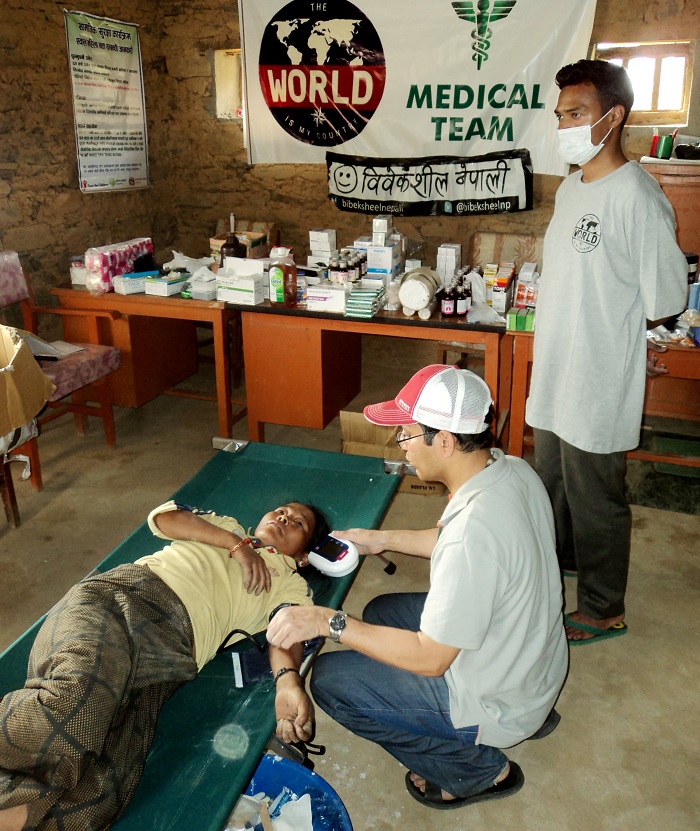
In Nepal the foundation also has a lot of volunteers and close ties to local Charities and that enable us to work efficiently with local communities. The Bibeksheel Nepali Party is a group of social entrepreneurs that quickly sprang into action by running a medical supplies warehouse and a team of local nurses and doctors. By joining up with them we not only received more than 15,000 USD of much needed medical supplies for free! But we also were given two doctors who we supported with logistics so they could access remote villages in the epicentre of the second earthquake which actually occurred when we were in Sindhupalchowk and at 7.4 on the Richter scale it’s an experience I for one have no desire to repeat!
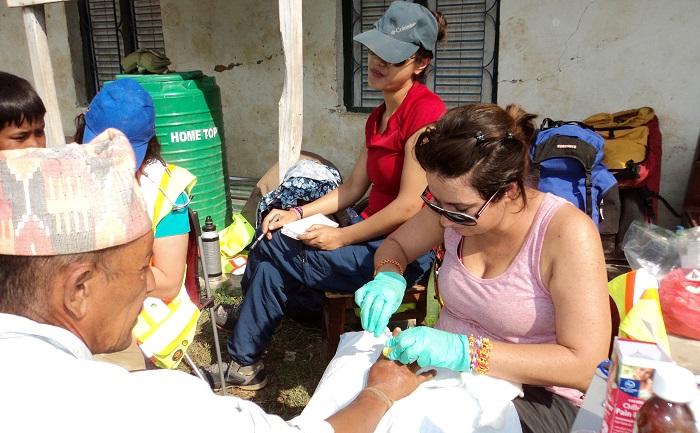
Later, we welcomed two medical volunteers from the UAE to our team in Nepal. Triona Coppinger from Al Ain came as an alternative medical practitioner and Natasha Mawditt from Abu Dhabi came as a First Aider. They were supported by a local Nepalese interpreter, Lilu KC who joined us for three weeks in the field and dedicated herself to helping us understand the needs of the locals.
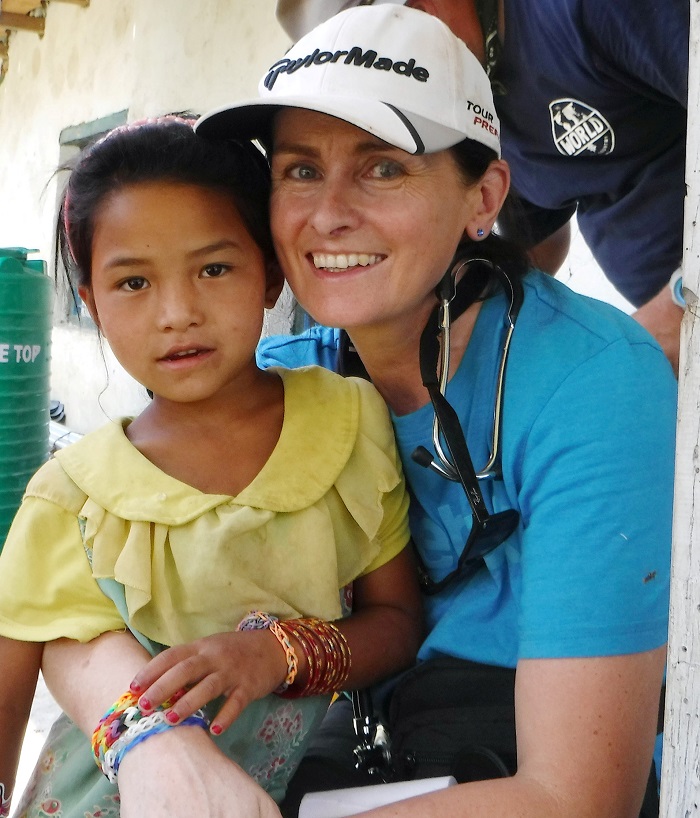
We also enlisted the help of a Nepalese engineer, Babin Ghimire and several village liaisons who made our time in the two remote locations we visited so much easier by acting as our go-betweens with the village councils.
Back in the UAE we were heavily supported by OutdoorUAE magazine who provided us with a paramedic pack and of course a month-off writing for me (my apologies to the readers for not writing my column in June’s issue, I was a bit busy!). We also received the loan of two satellite phones from two members of the Land Rover Owners Club UAE.
May was a month of delivering more than three tons of food aid to 250 people, treating 300+ people in our medical camps and starting to build 63 transitional homes for a remote village. Now we are aiming to send more volunteers out to Nepal to not only carry aid supplies for us and to volunteer in our programs but also to start bringing much needed money back into the Nepalese economy. Out of seven main trekking areas in Nepal, only three were damaged and the rest not only have undamaged trails and teahouses but are also in safe locations away from potential avalanches and landslides.
Companies that are organizing new holiday packages for September onwards to encourage tourists to return to Nepal are right when they state that “Most of Nepal is still safe for visitors”. The affected areas are mostly far from the trekking routes and the majority of hotels in Kathmandu also survived.
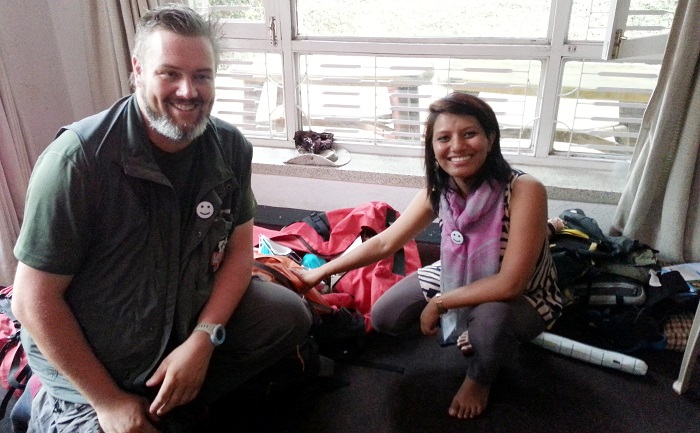
Nepal’s economy is crying out for tourism money. The majority of Nepal is untouched by the earthquakes and areas like Chitwan National Park and Pokhara are perfectly safe for tourists. Tribhuvan International Airport which is built on bedrock suffered almost no damage and is open for all flights. The main roads around the country were all opened very quickly and are now as full as normal with tourist buses and honking cars!
Nepal is going to take many years to get back on her feet and to rebuild the damaged areas and infrastructure and a vital part of this rebuilding process will come through tourism. This is a country that needs to feel a sense of normalcy again, and with its empty cafes and lack of foreigners who normally fill this beautiful region, it is feeling a bit forlorn and desolate. Volunteerism is already popular in Nepal and a large part of future tours and expeditions will hopefully be geared up towards raising funds for specific projects or helping out with skilled volunteers.
The UAE is ideally placed as a staging point for tourists travelling to Southeast Asia and with so many airlines to choose from including budget flights. It is much cheaper to travel to Nepal than people imagine. Hotels are cheap and the food is both excellent and very reasonable. Most countries can get the visa at the airport on arrival in Kathmandu and it is only 45 USD for a month or 15 USD for a long weekend. The best short trip is around seven days which allows you to see the valley and travel outside it too and your flight will come in less than 1500 AED return and the additional costs can be easily covered on a budget of 1000 AED. Once there you can indulge almost every adventure sport or relaxation or cultural interest imaginable and since the UAE has so many migrant workers from Nepal you will have ample opportunity to practice some Nepali language before you leave!
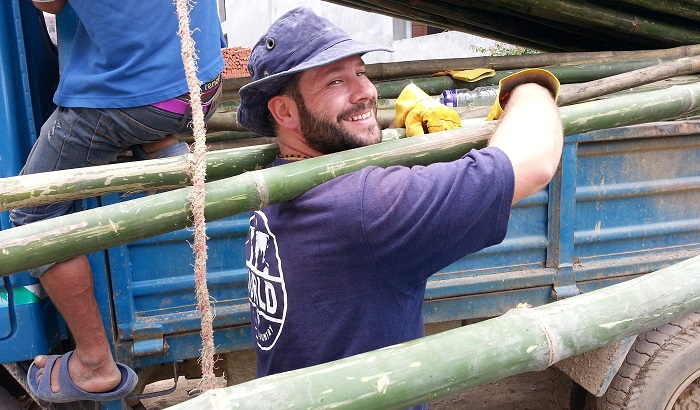
So if you have been following the disaster in Nepal and you want to know how you can really help these people, then get down to a travel agent and check out their latest tour package to Nepal. All the money you spend in Nepal will help to boost their economy and a time like this when they have suffered so much in the last few months not only your tourist money but also your smile and showing you care is what will really help these wonderful people to get back on their feet and rebuild Nepal.
Dan Wright and Dave Mawditt flew back out to Nepal on the 23rd of June to carry 200kgs of equipment for the Nepalese engineering team so they could begin building 63 transitional homes in the remote village of Gurdum. The team is now well on its way to completing this vital project in time to shelter these families from the monsoon and the following winter. You can follow their progress by visiting their Facebook page at facebook.com/theworldismycountryfoundation
Words By: Dan Wright

